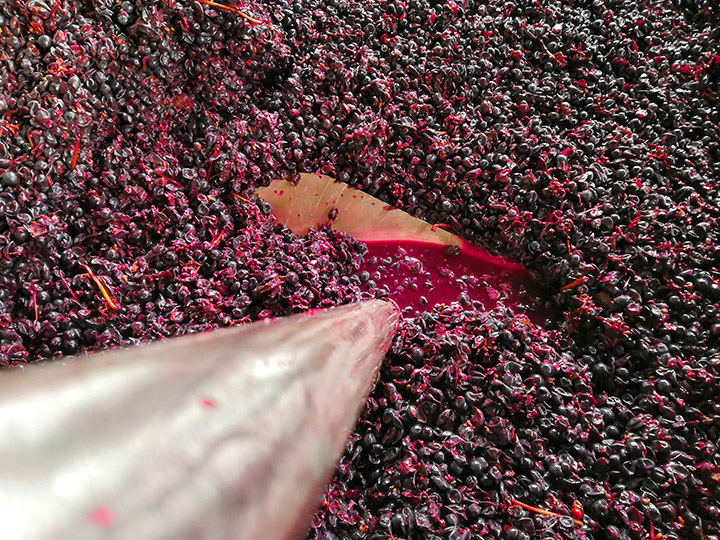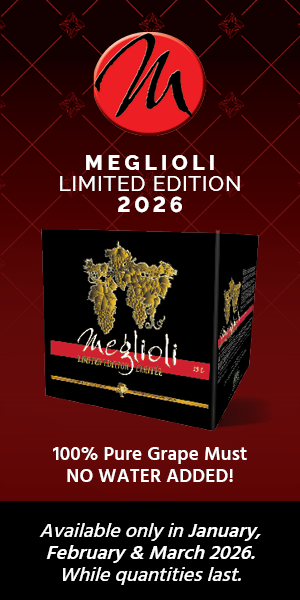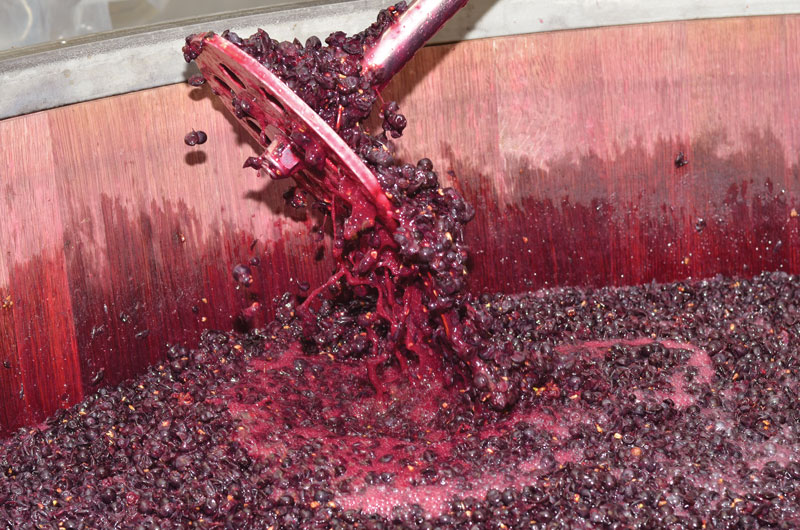You’re absolutely right to be thinking about how temperature affects the color of your final wine, especially if you’re fermenting outdoors. How cold or how warm a fermentation is plays a huge role in color extraction and it might just be the missing piece in your winemaking puzzle.

Color in red wine comes primarily from anthocyanins, the pigments found in grape skins. Getting those pigments out of the skins and into your wine depends on a few key factors: Temperature, skin contact, cap management, and sometimes a little enzymatic help. You’re already punching down twice a day, which is great. Keeping those skins in contact with the juice is essential for encouraging extraction, and punchdowns are an ideal way to do that. But if your must is too cold over the course of fermentation, you could be working hard without seeing the full benefit.
Fermentation temperature is one of the biggest drivers of color extraction. Warmer fermentations (generally in the range of 75–90 °F/24–32 °C) allow the cell walls in the grape skins to soften and break down more efficiently, releasing not just color but tannins, flavors, and aroma compounds. When things run too cool, which can easily happen outdoors, extraction slows dramatically. Yeast activity also lags in cooler temperatures, and since fermentation itself generates heat, a sluggish ferment can stall both your fermentation and your color development. If you suspect your red must is dipping below 70 °F (21 °C) and staying there, especially in the early days, I’d definitely recommend warming things up a bit. Even just insulating the fermenter with a blanket (electric blankets on low settings work especially well) or moving it to a warmer space can make a big difference.
Another thing to consider (and one that’s a bit underused in the home winemaking world) is the use of macerating enzymes. These are pectinase-based enzyme products designed to help break down the cell walls of grape skins more efficiently, which in turn releases more color. They’re especially helpful with thicker-skinned or less-ripe grapes where natural extraction may be more limited. A small dose at the crush or during a cold soak (if you’re doing one) can help release more anthocyanins early, when they’re most likely to bond with tannins and become stable over time. I’ve seen great results using maceration enzymes with grapes that come in a little underripe or with skins that just don’t want to give it up easily. Just be sure to follow the dosage instructions on the label as a little goes a long way.
You didn’t mention if you’re doing a cold soak, but that’s another technique you could try to enhance color. By holding your must at a low temperature for a few days before fermentation kicks off (say, in the 45–55 °F/7–13 °C range) you can allow for gentle extraction of some color compounds without pulling too many harsh tannins. This method is especially useful if you’re working with more delicate fruit or aiming for a softer, more fruit-driven red. Cold soaking does require some temperature control, so if your outdoor environment is unpredictable, it might be tricky; you don’t want to incubate spoilage bacteria. But it’s worth experimenting with if you want to boost your extraction in a gentle way.
Once fermentation gets rolling, keep an eye on the cap. You’re already punching down twice daily, which can be plenty for smaller-scale fermentations. During the height of active fermentation, like when Brix is dropping over 2 degrees per day, you may want to do three or even four punchdowns daily. Make sure you’re getting good coverage by breaking up the cap and submerging it. You don’t need to be that aggressive at the beginning or the end of fermentation; once a day can be sufficient.
After fermentation, be careful with how hard you press. It can be tempting to squeeze every last drop from your skins, but aggressive pressing can release bitter, green-tasting tannins that not only muddy the flavor, but which can be difficult to remove or fine out afterwards. Press gently and taste often during this step. Sometimes the best part of color extraction is already behind you, and the goal shifts to protecting and preserving what you’ve gained.
Finally, once your wine is safely aging away and is protected from oxygen, keep in mind that color isn’t static, it evolves. If you’re aging your wine in oak, especially new or medium-toast barrels, you may actually see a stabilizing effect over time. The tannins in oak can bind with anthocyanins, forming more stable color complexes that hold up better as the wine matures. This is another great reason to follow one of the Wine Wizard’s oldest tips to the readership — ferment on 1–2 g/L of highest-quality fine oak chips. That way you start stabilizing your color right from the beginning.
To sum it up: Yes, temperature is critical to color development in red wines, and it’s likely the key area to focus on if you’re looking to boost the vibrancy of your finished product. Warmer fermentation temperatures, consistent cap management, the (not too aggressive) use of macerating enzymes, and gentle pressing practices can all work together to help you get the most from your grapes.




